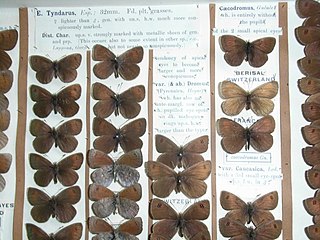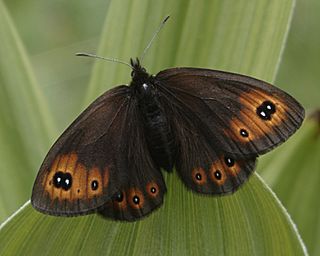
The small mountain ringlet or mountain ringlet is a butterfly of the family Nymphalidae. It is found in mountainous regions of southern and central Europe.

Mount Cook is a high peak on the Yukon Territory-Alaska border, in the Saint Elias Mountains of North America. It is approximately 15 miles southwest of Mount Vancouver and 35 miles east-southeast of Mount Saint Elias. It forms one of the corners of the jagged border, which is defined to run in straight lines between the major peaks. The same border also separates Kluane National Park in the Yukon Territory from Wrangell-St. Elias National Park and Preserve in Alaska.
Panthera youngi is a fossil cat species that was described in 1934; fossil remains of this cat were excavated in a Homo erectus formation in Choukoutien, northeastern China. Upper and lower jaws excavated in Japan's Yamaguchi Prefecture were also attributed to this species. It is estimated to have lived about 350,000 years ago in the Pleistocene epoch. It was suggested that it was conspecific with Panthera atrox and P. spelaea due to their extensive similarities. Some dental similarities were also noted with the older P. fossilis, however, Panthera youngi showed more derived features.

Erebia is a Holarctic genus of brush-footed butterflies, family Nymphalidae. Most of the about 90–100 species are dark brown or black in color, with reddish-brown to orange or more rarely yellowish wing blotches or bands. These usually bear black spots within, which sometimes have white center spots.

Erebia euryale, the large ringlet, is a species of butterfly belonging to the family Nymphalidae.

Erebia tyndarus, the Swiss brassy ringlet, is a European brush-footed butterfly species of the subfamily Satyrinae.

The brassy ringlets are a species group of ringlet butterflies in the genus Erebia. Though closely related, their monophyly is not completely resolved. Still, the brassy ringlets are taxa similar to E. tyndarus – the Swiss brassy ringlet –, and in many cases certainly close relatives. A notable trait of their genus is an ability to adapt well to cold and somewhat arid habitat, like taiga or regions with alpine climate. Optimal habitat in Eurasia, where most of the brassy ringlets are found, therefore occurs in two distinct belts – in the very north of the continent and in the Alpide belt – in interglacials, and in glacials in one periglacialic belt at lower altitude, in places interrupted by dry wasteland and deserts.

Erebia epipsodea, the common alpine, is a butterfly species of the subfamily Satyrinae of family Nymphalidae. It is found in North America from Alaska south through the Rocky Mountains to northern New Mexico and east across the prairie provinces to southwest Manitoba.

Erebia melampus, the lesser mountain ringlet, is a member of the subfamily Satyrinae of the family Nymphalidae.

Erebia rossii, the Arctic alpine or Ross's alpine, is a member of the subfamily Satyrinae of the family Nymphalidae. It is found in Arctic North America and northern Eurasia.
Erebia lafontainei, the reddish alpine or Lafontaine's alpine, is a member of the subfamily Satyrinae of the family Nymphalidae. It is found in northern North America from Alaska, Yukon, and western Northwest Territories as far east as Tuktoyuktuk.
Erebia anyuica, the scree alpine, is a member of the subfamily Satyrinae of family Nymphalidae. It is found in Siberia, in several isolated areas of Alaska, and in a band that extends across northern Alaska and northern Yukon to the Richardson Mountains on the Yukon/Northwest Territories border.
Erebia pawloskii, the yellow-dotted alpine, is a member of the subfamily Satyrinae of the family Nymphalidae. It is found in North America in northern British Columbia, Yukon, and Alaska. It is also found in the Sayan Mountains, and from northern Mongolia to Yakutia and Kamchatka. The habitat consists of grassy areas in and above wet tundra, as well as bogs.

Erebia discoidalis, the red-disked alpine, is a member of the subfamily Satyrinae of family Nymphalidae. It is found in North America from eastern Quebec, through northern Ontario, and the northern Prairies to northern British Columbia, the Northwest Territories, Yukon, and Alaska. It reaches just into the northern U.S. between Michigan and Montana, and also occurs in Asia, where it has been recorded from the Chukot Peninsula to the eastern Sayan Mountains and Amur. The habitat consists of large, open, grassy bogs and other areas with acidic soils.

Erebia fasciata, the banded alpine, is a member of the subfamily Satyrinae of family Nymphalidae. It is found from central Siberia, through Alaska, Yukon, and mainland Northwest Territories and Nunavut to Hudson Bay. It also occurs on Banks Island and Victoria Island.
Erebia mackinleyensis, the Mt. McKinley alpine, is a member of the subfamily Satyrinae of family Nymphalidae. It is found from eastern Siberia through Alaska and Yukon, just reaching into the Northwest Territories in the Richardson Mountains and into British Columbia at Stone Mountain Provincial Park.
The Magdalena alpine is a member of the subfamily Satyrinae of the family Nymphalidae. It is found in North America from Montana, Colorado, Utah, and New Mexico, and in Canada in a small part of the Willmore Wilderness Park, Alberta, and adjacent British Columbia, in Stone Mountain Provincial Park in northern British Columbia, and on an isolated nunatak in Kluane National Park and Reserve, Yukon. The habitat consists of rockslides near vegetation, at or above the treeline.
Erebia mancinus, the taiga alpine, is a member of the subfamily Satyrinae of the family Nymphalidae. It lives in subarctic North America from Labrador, northern Quebec, and northern Ontario, through the northern Prairie Provinces, northern British Columbia, and the interior of the Northwest Territories to Yukon and Alaska. It also ranges south in the mountains as far as Banff, Alberta. The habitat consists of black spruce-sphagnum bogs.










